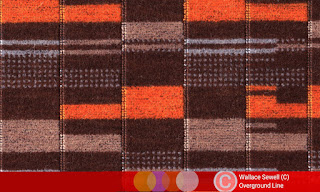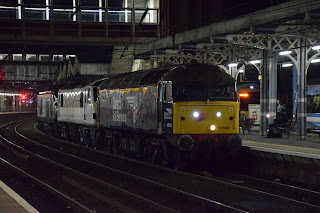Pt 1. Iconic Moquette, TFL ~ WallaceSewell
AUTO-POST: In the Mid-Century Magazine, I had recently read about Wallace Sewell. At first, the majority of us wouldn't recognise the company name, but at first glance their designs are just as iconic as Harry Beck's Transport For London Map.
So I've decided to create this series, going through a few of the moquette designs that have been adorned inside London Underground stock.
In 1990 Harriet Wallace-Jones and Emma Sewell graduated from the Royal College of Art, creating their company Wallace Sewell which make products like cushions and throws.
 |
| Tramlink to Croydon. WallaceSewell And London Transport Museum. |
'How did the commissions for Transport for London come about? We were invited as part of a group of five companies to create designs for the Overground moquette and, following this experience, the Tramlink moquette design was commissioned. We won the opportunity to design the Underground moquette design in a competition that had over over 300 entries.
What were the inspirations behind your TfL moquettes? We also make scarves, throws and cushions and some of our early chenille throw designs were ‘in homage’ to the classic Misha Black design [his geometric orange, yellow, brown and black 1978 District design used across buses and trains], and it had always been a dream and ambition to follow in his and Marianne Straub’s footsteps [Straub’s blue/green design was used on all new buses and trains entering service from 1969 until 1978].
When designing the moquettes, we tried to capture the simplicity and boldness of the classic mid-century designs, whilst giving them an extra complexity. We achieved this either through disguising the repeat by using varying yet similar elements over a large area, as in the Overground and the Tramlink moquettes. Or by doing the opposite and shrinking the repeat size right down while incorporating various abstracted London landmarks in the design, as in the Underground design.
How does their purpose inform the design of the moquettes? All designs need to be small scale, broken up yet bold to mask the heavy usage. They all have to fit exact industrial parameters relating to the looms they are woven on. With the first three projects, the designs had to be created using a very tight four-colour palette, briefed by TfL, and we utilised colour theory to make it appear that there are more than the given four colours.
However, with a recent commission to create a design for the Crossrail Interim trains, we could select the palette ourselves, and responded to the buildings and surroundings on the route, while pushing the industrial possibilities to create a design that is relatively cheap to produce, yet has a broad group of colours in its pattern.
How does it feel to know that millions of people are being brought into daily contact with your designs? It is incredibly exciting to design for the public domain. It was part of what led me to study design. Growing up, I always felt that one should be able to create strong exciting designs, that are bold, perform, yet fit an exacting industrial brief. I feel that having strong, considered design around us can be a positive addition to one’s life – making one respond, even if in an unconscious way!
Can you tell us a bit about your working practice? We are inevitably influenced by our surroundings. Harriet takes inspiration from the Dorset landscape surrounding her studio, from the division of the countryside into varying proportions to the juxtaposition of colours and textures. I find my urban surroundings in London inspiring on the same level, plus I’m an avid person watcher, and love the diverse eclectic mix of people one encounters on a day to day basis.
We’re supported by a fantastic team based here in London and at the family-run mill we work with in Lancashire, where production happens. We’ve very much embraced the British Textile Industry for its wealth of expertise and excellence and we’re proud to have always woven in the UK.
In 2011, they also designed the Barman Central Line stock seat design (named after Christian Barman, who commissioned the first TFL Moquettes back in 1936) showing the London landmarks. This design is shown above. Barman decided that there should be a brand for seat patterns developed when he was TFL publicity manager between 1935 and 1941.
Part 2 is tomorrow. In the meantime, why not look at the interiors of the TFL Tube network? See this link. ^Harry
Part 2 is tomorrow. In the meantime, why not look at the interiors of the TFL Tube network? See this link. ^Harry








